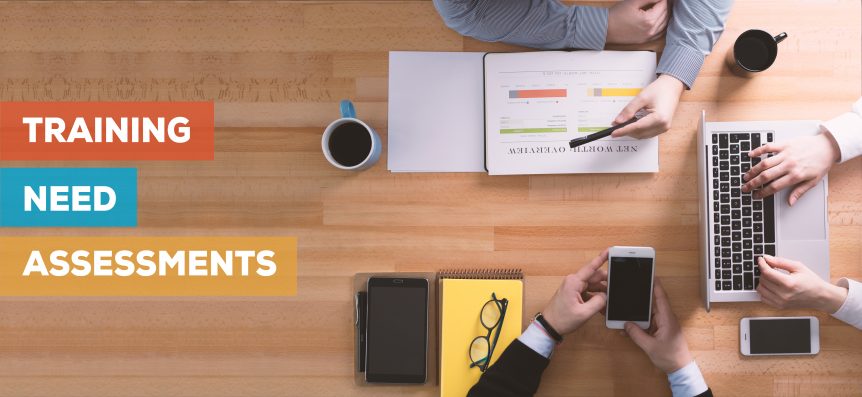What Is a Training Needs Analysis and How Are They Beneficial?
Do you conduct regular training needs analysis in your organisation? If not, it’s something you should do as it will improve training in your business. It can also help improve business performance, productivity, and profitability.
It’s not even a time-consuming process. Instead, it’s about spending a short amount of time to get a full understanding of your company’s needs in relation to training.
What is a Training Needs Analysis?
A training needs analysis is a process to determine the training your team requires to improve performance, ensure regulatory compliance, and grow your business.
It involves:
- Deciding the skills and knowledge the members of your team need. This includes performance-related skills, knowledge of compliance issues, and more. Often, you will have different lists of requirements depending on individual roles, seniority, location, etc.
- Evaluate the current skills and levels of knowledge among members of your team.
- Highlight the current skills and knowledge gaps in your organisation.
This process of identifying the skills and knowledge gaps in your company will help you decide the e-learning training modules you need to introduce.
A Training Needs Analysis is Different to a Performance Analysis
Sometimes, organisations confuse the process of conducting a performance analysis with conducting a training needs analysis. They are different, however.
A performance analysis involves assessing your company’s current performance and position in the market. With this information, you can then decide on the areas you want to further develop and improve.
So, you can use a performance analysis to help with the process of completing a training needs analysis, but you should do the performance analysis first.
The Benefits of Conducting a Training Needs Analysis
There are seven main benefits of conducting a training needs analysis in your Dubai business.
1. Prioritises Your Training Focus
A training needs analysis ensures you prioritise your training efforts. After all, the skills and knowledge gaps you identify as part of the training needs analysis will not have equal importance.
Understanding all the gaps in your business will make sure you get the priorities right.
2. Identifies Skills and Knowledge Gaps Before They Start Causing Problems
With compliance issues, for example, identifying knowledge gaps reduces risks in your business.
For performance-related skills, identifying and dealing with skills gaps as early as possible helps your business progress and meet its objectives. It also helps you stay ahead of your competition.
3. Identifies Gaps You Were Not Aware Of
A training needs analysis can identify skills and knowledge gaps you might not know about or might not have thought to consider. Without going through the training needs analysis process, the gap will remain unaddressed, potentially causing damage to your business or preventing it from achieving its full potential.
4. Maximises ROI
Conducting a training needs analysis also maximises the return on investment you get from your training budget. This is because the analysis will result in you allocating your training resources to the most important areas.
5. Improves Training Planning
Following on from the last point, a training needs analysis takes the guesswork and assumptions out of training strategy and implementation planning. The analysis will give you a holistic overview of your organisation’s needs which then allows you to focus your resources in the right areas.
Planning training in this way is more efficient, plus you will end up with a plan that is better suited to achieving the objectives of your business.
6. Improves Training Targeting
The knowledge and skills gaps in your company will differ depending on the individual, team, or level of seniority. These differences will be identified in the training needs analysis.
With this information, you can not only prioritise the most important training needs, but you can create and target training for those who need it most.
7. Improves Learner Engagement
Learners are much more engaged when they value training. In addition, learners are more likely to value training if they feel they are progressing and/or improving as a result.
A training needs analysis ensures they receive the training they truly need. This improves learner engagement and overall participation in your training strategy.
Training Needs Analysis Tips
- Liaise closely with department heads and managers during the process – they will know their teams best as well as the pressures and performance issues they face
- Use a variety of training delivery methods – once you identify the skills and knowledge gaps you need to fill, spend time deciding on the most appropriate method of training delivery. E-learning will be suitable in a wide range of situations, but your training strategy is also likely to benefit from a combination of methods.
- Evaluate each training module – as you have conducted a training needs analysis, you will have a clear understanding of the skills and knowledge gaps the training module is aimed at addressing. It’s important you then assess the training module as well as learner performance to ensure it is delivering as you expected.
- Evaluate your overall training strategy – finally, evaluate your overall training strategy in relation to the training needs analysis that led to its creation. Did you prioritise the right skills and knowledge gaps and did the training subsequently developed follow through on this prioritisation? Did you target the right learners, and did you get buy-in from all those involved?
Your training strategy should be as structured and planned out as possible. Conducting a training needs analysis is an important part of the process.
